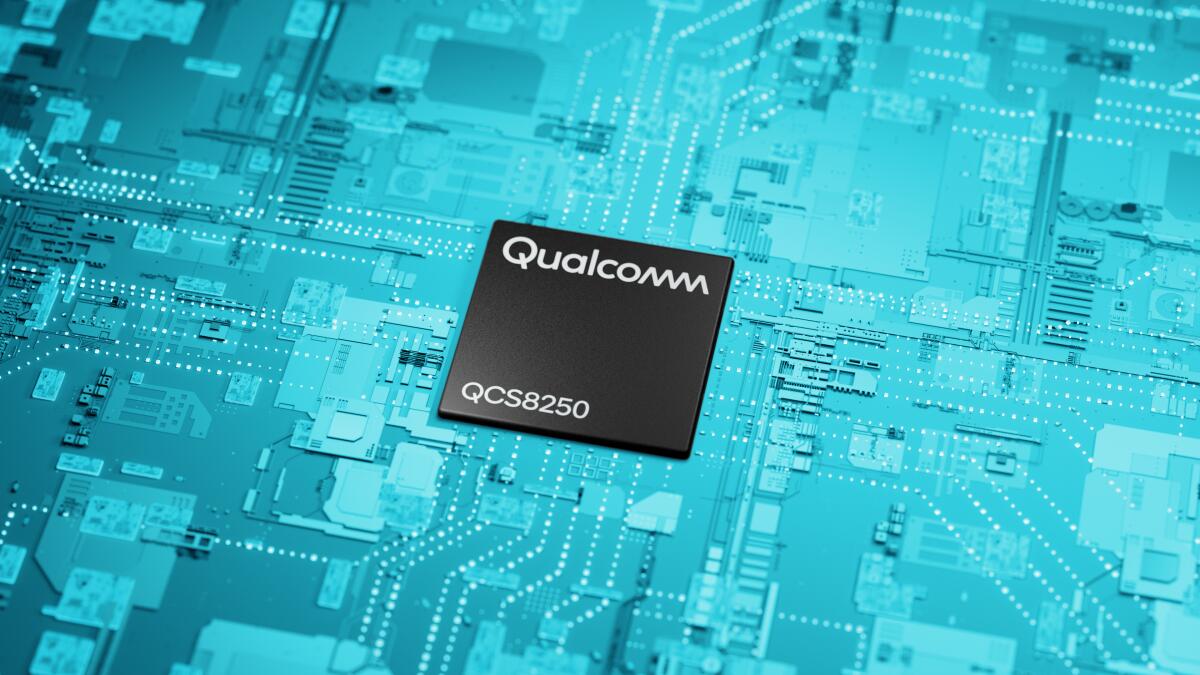At CES, chipmakers show off plans to go after one another’s turf

- Share via
The biggest U.S. chipmakers — including Intel Corp., Nvidia Corp., Advanced Micro Devices Inc. and Qualcomm Inc. — are starting off 2022 by unveiling products that push further into one another’s main territories, signaling they’re girding for tough competition as semiconductor demand increases across industries.
Intel, clinging to its title of world’s largest chipmaker by revenue, showed off graphics chips aimed at fighting Nvidia and AMD in their area of domination. Nvidia’s latest chips are targeted at persuading more laptop owners to choose its highly specialized graphics capabilities, and AMD touted products meant to maintain its market share gains.
Qualcomm, the biggest maker of mobile-phone chips, bolstered its push to win a chunk of the personal-computer market, leveraging its strength in smartphone technology.
The flurry of announcements at the annual CES technology conference, based in Las Vegas but mostly taking place virtually, highlights the shifting competitive landscape for the group of companies whose technology rules the computer and mobile-phone industries. Intel’s loss of leadership in chip-manufacturing technology has exposed it to challenges from newly confident rivals in the PC market. The company’s response under Chief Executive Pat Gelsinger is to defend that market and, at the same time, to chase sales in its rivals’ strongest businesses.
New workplace laws taking effect in January strengthening employees’ health, safety and wage protections and ban corporate muzzling of discrimination victims. But many more mandates tagged “job killers” were stopped from becoming law.
That fight will probably play out beyond 2022, with most analysts predicting Intel will struggle to boost sales this year, compared with revenue gains forecast for the other companies.
In an online presentation earlier in the day, Intel announced its 12th generation Core mobile processors, including 28 new models that are as much as 40% faster than their predecessors. Crucially, it also said new Arc graphics chips are being shipped to PC makers, including Acer Inc., Dell Technologies Inc. and HP Inc., which will use them in upcoming machines aimed at gamers.
The Arc chips are Intel’s attempt to cut into the dominance of Nvidia and AMD in high-end graphics. More laptops are using add-in graphics cards to bolster capabilities in gaming and content creation, which are increasingly determining customer preferences. Intel’s chips in the past have only offered graphics built into main microprocessors, typically with less power to generate realistic images.
Nvidia countered by unveiling new graphics chips for laptops, aimed at bringing high-end gaming and artificial intelligence capabilities to the thinnest and lightest computers.
The GeForce RTX 3080 Ti graphics processor will equip notebooks that will be priced starting at $2,499, giving them better capabilities than many previous high-end desktop models, Nvidia said Tuesday in a virtual presentation. Laptop models running on the 3070 Ti chip will start at $1,499.
Nvidia, whose market value is larger than any other chipmaker, is rolling out new products as it works to broaden the reach of its technology into the laptop market. Most thin computers contain what’s called integrated graphics, capabilities typically built into central processors from Intel or AMD.
Also as part of CES, AMD Chief Executive Lisa Su showed off new laptop and graphics processors meant to continue the company’s run of stealing market share from Intel. AMD’s graphics chips have come closer in performance to Nvidia’s, but the larger company still controls the majority of the market for add-in cards for PC gamers that can cost more than $1,000.
And in one of the few remaining in-person appearances at CES, Qualcomm CEO Cristiano Amon spoke about his commitment to bringing smartphone technology-based processors to the PC market. He listed customers such as Microsoft Corp., Acer and Lenovo.
Qualcomm’s chief also talked up his push into automotive semiconductors, unveiling chips that will help cars pilot themselves. That move will put him in more direct competition with Intel’s Mobileye unit and Nvidia, which is also working to make chips to be the brains of vehicles of the future.
More to Read
Inside the business of entertainment
The Wide Shot brings you news, analysis and insights on everything from streaming wars to production — and what it all means for the future.
You may occasionally receive promotional content from the Los Angeles Times.











